Key Challenges in Talent Management for Unilever's Marketing Sector
VerifiedAdded on 2022/12/26
|20
|4861
|91
Project
AI Summary
This project investigates the key challenges and obstacles in talent management, focusing on the marketing sector of Unilever. The project begins with an introduction to talent management and its importance, followed by the project's aims, objectives, and a detailed project management plan, including deliverables, timelines, resource allocation, and risk assessment. The work breakdown structure and Gantt chart are also provided. The research methodology, including research type, philosophy, approach, and design, is explained, along with data collection and analysis methods, incorporating both primary and secondary research. Primary data collection involves questionnaires, while secondary data includes literature reviews. The data analysis section presents findings from the research, including a literature overview, and provides a discussion of the challenges and solutions. The project concludes with recommendations for improving talent management within Unilever's marketing sector, followed by a personal performance review and a comprehensive list of references and appendices.
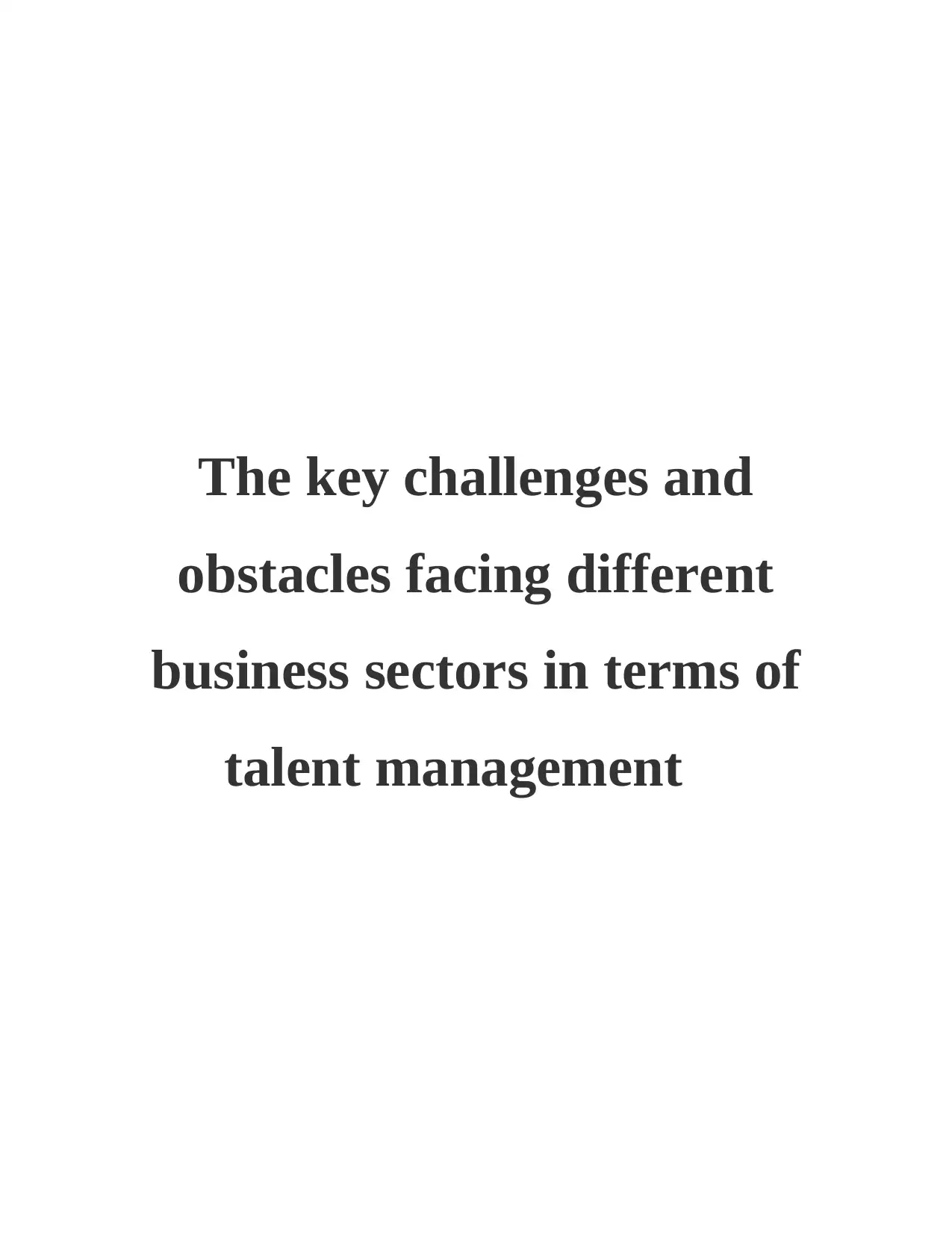
The key challenges and
obstacles facing different
business sectors in terms of
talent management
obstacles facing different
business sectors in terms of
talent management
Paraphrase This Document
Need a fresh take? Get an instant paraphrase of this document with our AI Paraphraser
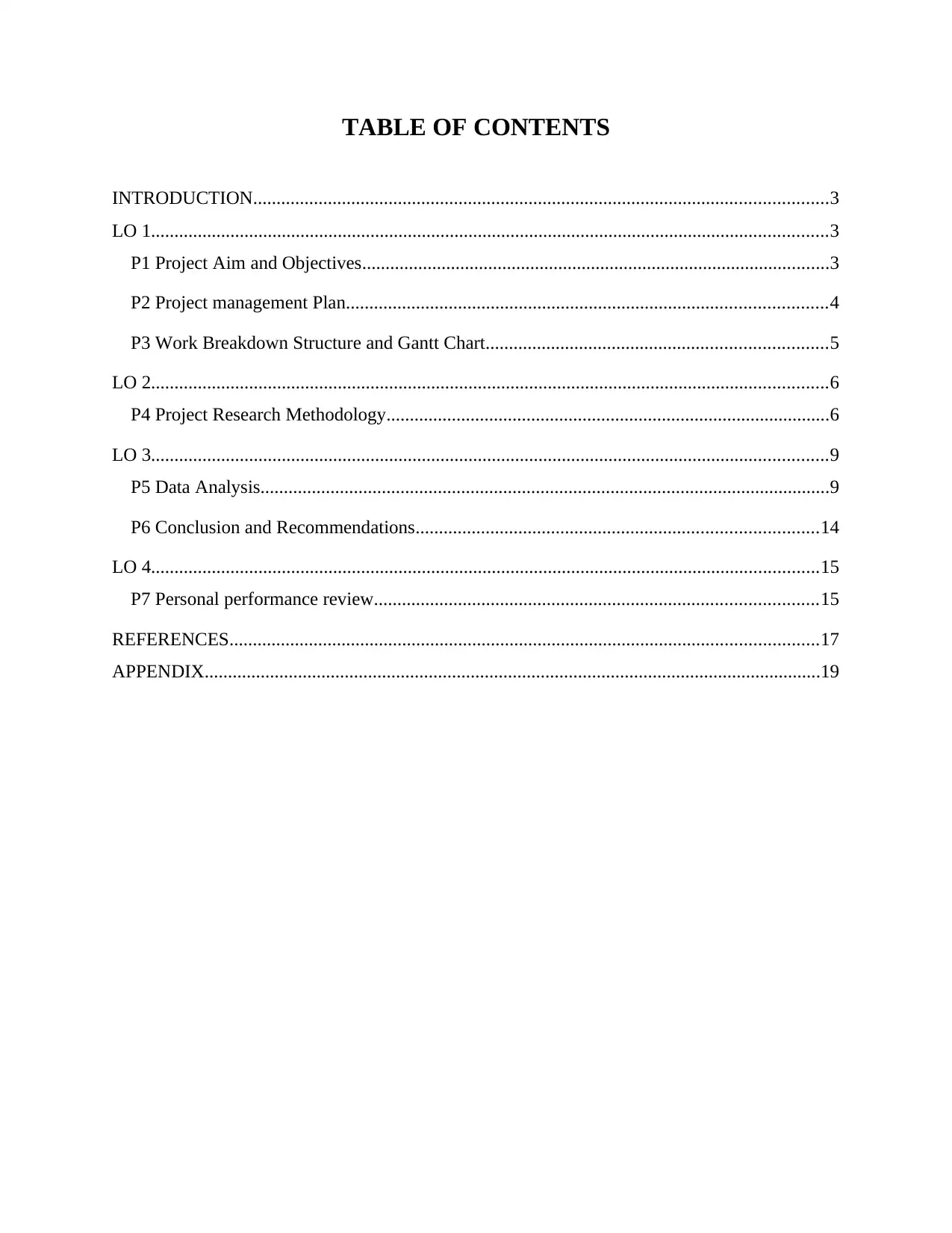
TABLE OF CONTENTS
INTRODUCTION...........................................................................................................................3
LO 1.................................................................................................................................................3
P1 Project Aim and Objectives....................................................................................................3
P2 Project management Plan.......................................................................................................4
P3 Work Breakdown Structure and Gantt Chart.........................................................................5
LO 2.................................................................................................................................................6
P4 Project Research Methodology...............................................................................................6
LO 3.................................................................................................................................................9
P5 Data Analysis..........................................................................................................................9
P6 Conclusion and Recommendations......................................................................................14
LO 4...............................................................................................................................................15
P7 Personal performance review...............................................................................................15
REFERENCES..............................................................................................................................17
APPENDIX....................................................................................................................................19
INTRODUCTION...........................................................................................................................3
LO 1.................................................................................................................................................3
P1 Project Aim and Objectives....................................................................................................3
P2 Project management Plan.......................................................................................................4
P3 Work Breakdown Structure and Gantt Chart.........................................................................5
LO 2.................................................................................................................................................6
P4 Project Research Methodology...............................................................................................6
LO 3.................................................................................................................................................9
P5 Data Analysis..........................................................................................................................9
P6 Conclusion and Recommendations......................................................................................14
LO 4...............................................................................................................................................15
P7 Personal performance review...............................................................................................15
REFERENCES..............................................................................................................................17
APPENDIX....................................................................................................................................19
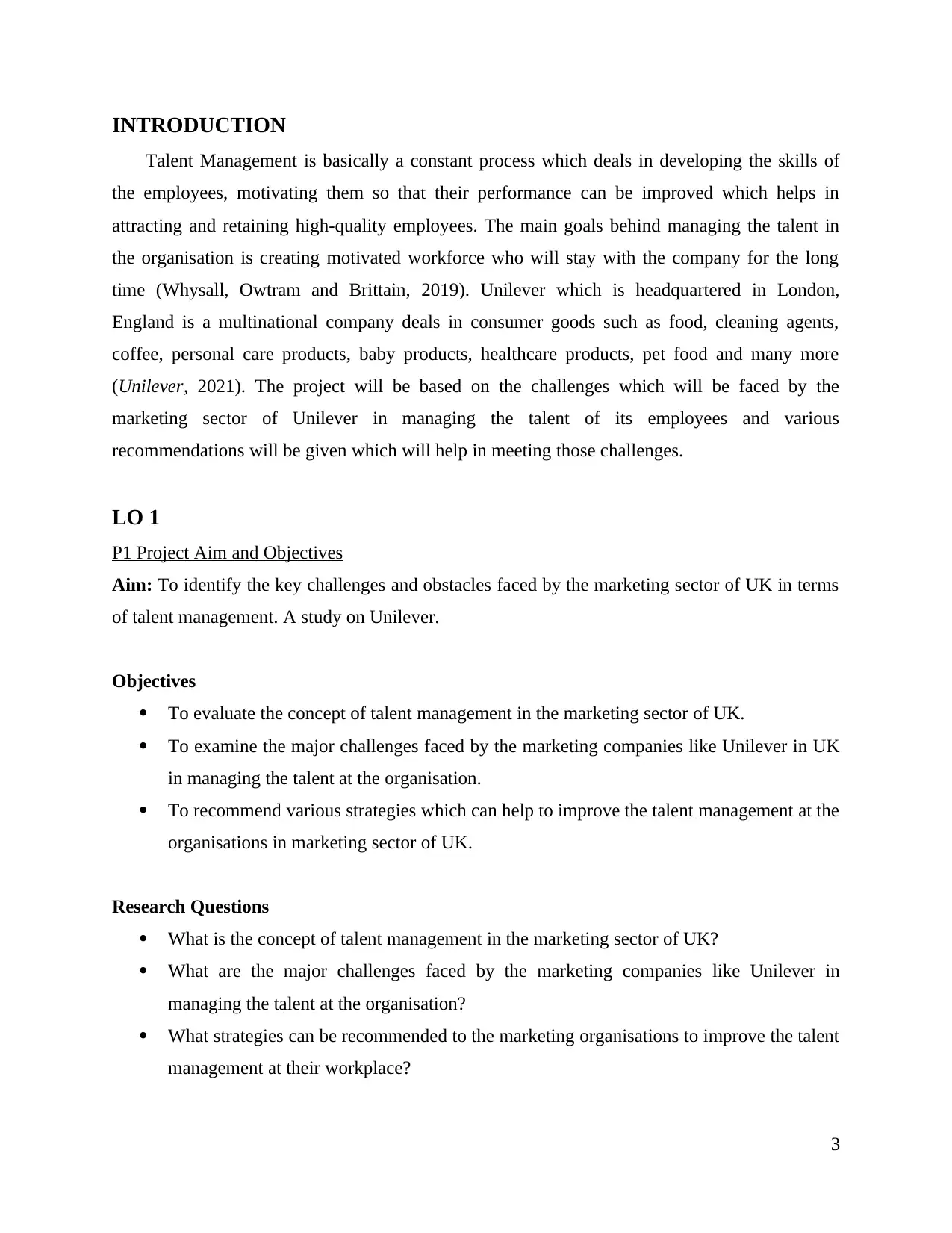
INTRODUCTION
Talent Management is basically a constant process which deals in developing the skills of
the employees, motivating them so that their performance can be improved which helps in
attracting and retaining high-quality employees. The main goals behind managing the talent in
the organisation is creating motivated workforce who will stay with the company for the long
time (Whysall, Owtram and Brittain, 2019). Unilever which is headquartered in London,
England is a multinational company deals in consumer goods such as food, cleaning agents,
coffee, personal care products, baby products, healthcare products, pet food and many more
(Unilever, 2021). The project will be based on the challenges which will be faced by the
marketing sector of Unilever in managing the talent of its employees and various
recommendations will be given which will help in meeting those challenges.
LO 1
P1 Project Aim and Objectives
Aim: To identify the key challenges and obstacles faced by the marketing sector of UK in terms
of talent management. A study on Unilever.
Objectives
To evaluate the concept of talent management in the marketing sector of UK.
To examine the major challenges faced by the marketing companies like Unilever in UK
in managing the talent at the organisation.
To recommend various strategies which can help to improve the talent management at the
organisations in marketing sector of UK.
Research Questions
What is the concept of talent management in the marketing sector of UK?
What are the major challenges faced by the marketing companies like Unilever in
managing the talent at the organisation?
What strategies can be recommended to the marketing organisations to improve the talent
management at their workplace?
3
Talent Management is basically a constant process which deals in developing the skills of
the employees, motivating them so that their performance can be improved which helps in
attracting and retaining high-quality employees. The main goals behind managing the talent in
the organisation is creating motivated workforce who will stay with the company for the long
time (Whysall, Owtram and Brittain, 2019). Unilever which is headquartered in London,
England is a multinational company deals in consumer goods such as food, cleaning agents,
coffee, personal care products, baby products, healthcare products, pet food and many more
(Unilever, 2021). The project will be based on the challenges which will be faced by the
marketing sector of Unilever in managing the talent of its employees and various
recommendations will be given which will help in meeting those challenges.
LO 1
P1 Project Aim and Objectives
Aim: To identify the key challenges and obstacles faced by the marketing sector of UK in terms
of talent management. A study on Unilever.
Objectives
To evaluate the concept of talent management in the marketing sector of UK.
To examine the major challenges faced by the marketing companies like Unilever in UK
in managing the talent at the organisation.
To recommend various strategies which can help to improve the talent management at the
organisations in marketing sector of UK.
Research Questions
What is the concept of talent management in the marketing sector of UK?
What are the major challenges faced by the marketing companies like Unilever in
managing the talent at the organisation?
What strategies can be recommended to the marketing organisations to improve the talent
management at their workplace?
3
⊘ This is a preview!⊘
Do you want full access?
Subscribe today to unlock all pages.

Trusted by 1+ million students worldwide

P2 Project management Plan
It is a formal document which helps in defining the ways in which the project will be
carried out. It also helps in outlining the goals, scope, budget, deliverables and timeline of the
project which are much necessary to keep the project on track.
Deliverables: The project will be broken down into various deliverables such as talent
management strategies for the Unilever and the related companies in marketing sector of UK and
also deep insight about the challenges which are faced by these companies. This will help in
attracting and retaining the skilled and talented employees.
Time: The time required for the completion of this project will be 12 weeks approx. and in this
time all the tasks like deciding the objective, selecting the research methods, conducting primary
and secondary research, gaining the findings and conclusion and making recommendations
(Ørngreen and Levinsen, 2017). This help in meeting the scheduled deliverables and also
completing the project before the completion date.
Quality: The project will be able to meet the need of the customers, employees as well as the
stakeholders from the project deliverables. The activities and the processes carried out in the
project will help in achieving the quality of the deliverables.
Risk: There can be various risks during the project such as cost risks if the cost estimating
accuracy is poor, schedule risks as the activities may take longer time than expected which will
increase the costs and also performance risk if the project fails to produce the consistent results
(Snyder, 2019).
Communication: The communication between the team and the stakeholders will be handled
throughout the project effectively so that the decision making can be improved and effective.
Resources: This includes the budget and other resources which are as follows:
Particulars Cost (in £)
4
It is a formal document which helps in defining the ways in which the project will be
carried out. It also helps in outlining the goals, scope, budget, deliverables and timeline of the
project which are much necessary to keep the project on track.
Deliverables: The project will be broken down into various deliverables such as talent
management strategies for the Unilever and the related companies in marketing sector of UK and
also deep insight about the challenges which are faced by these companies. This will help in
attracting and retaining the skilled and talented employees.
Time: The time required for the completion of this project will be 12 weeks approx. and in this
time all the tasks like deciding the objective, selecting the research methods, conducting primary
and secondary research, gaining the findings and conclusion and making recommendations
(Ørngreen and Levinsen, 2017). This help in meeting the scheduled deliverables and also
completing the project before the completion date.
Quality: The project will be able to meet the need of the customers, employees as well as the
stakeholders from the project deliverables. The activities and the processes carried out in the
project will help in achieving the quality of the deliverables.
Risk: There can be various risks during the project such as cost risks if the cost estimating
accuracy is poor, schedule risks as the activities may take longer time than expected which will
increase the costs and also performance risk if the project fails to produce the consistent results
(Snyder, 2019).
Communication: The communication between the team and the stakeholders will be handled
throughout the project effectively so that the decision making can be improved and effective.
Resources: This includes the budget and other resources which are as follows:
Particulars Cost (in £)
4
Paraphrase This Document
Need a fresh take? Get an instant paraphrase of this document with our AI Paraphraser
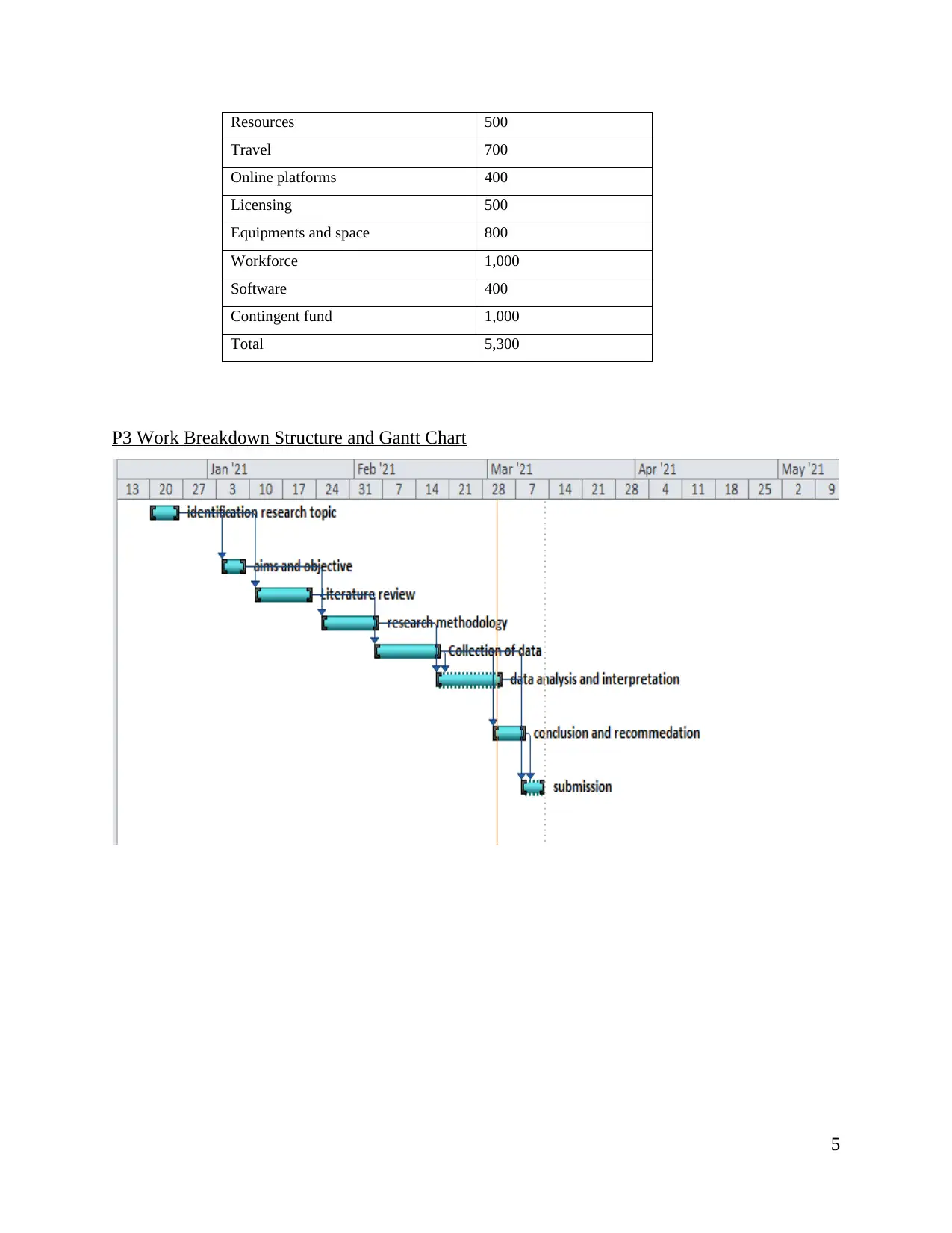
Resources 500
Travel 700
Online platforms 400
Licensing 500
Equipments and space 800
Workforce 1,000
Software 400
Contingent fund 1,000
Total 5,300
P3 Work Breakdown Structure and Gantt Chart
5
Travel 700
Online platforms 400
Licensing 500
Equipments and space 800
Workforce 1,000
Software 400
Contingent fund 1,000
Total 5,300
P3 Work Breakdown Structure and Gantt Chart
5
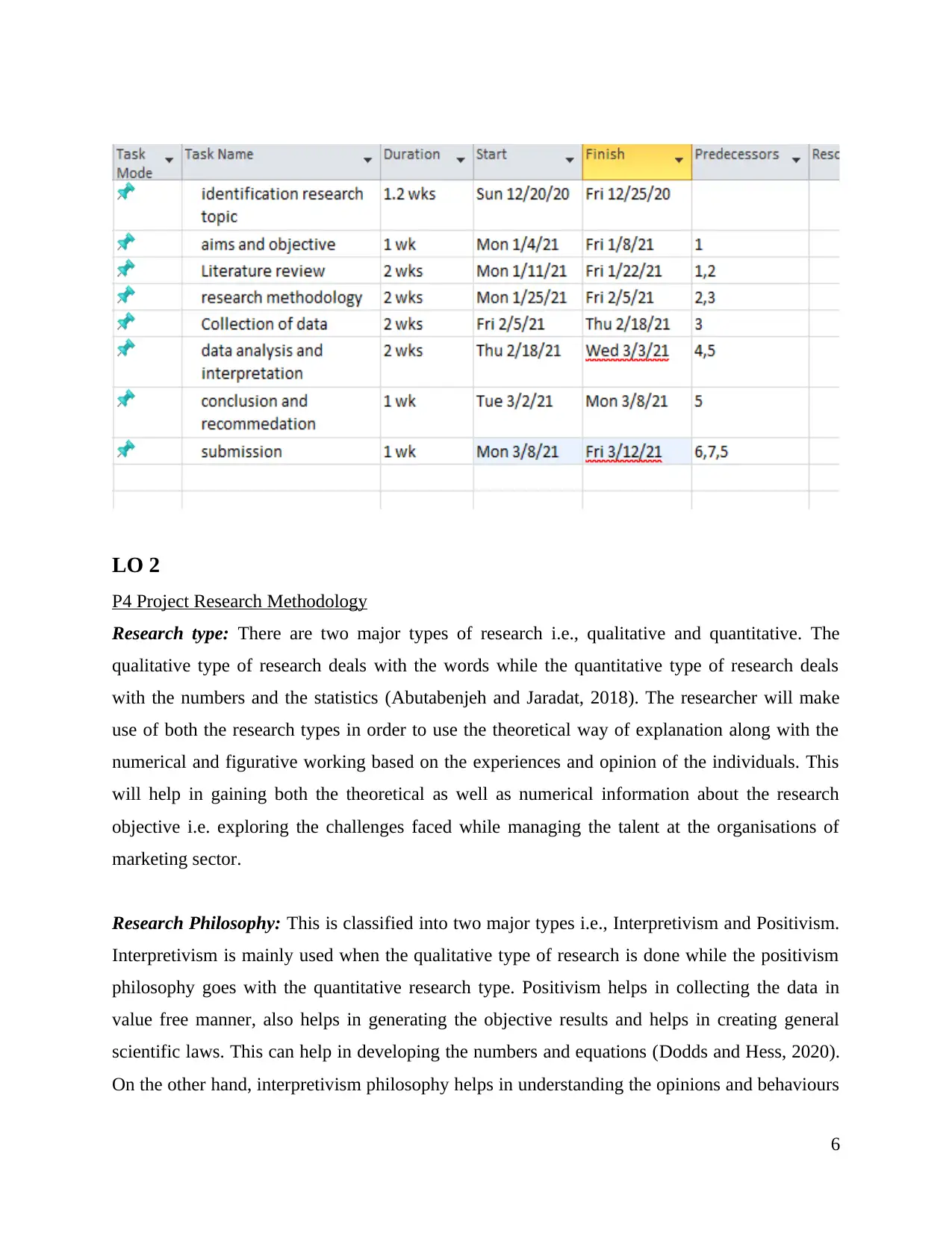
LO 2
P4 Project Research Methodology
Research type: There are two major types of research i.e., qualitative and quantitative. The
qualitative type of research deals with the words while the quantitative type of research deals
with the numbers and the statistics (Abutabenjeh and Jaradat, 2018). The researcher will make
use of both the research types in order to use the theoretical way of explanation along with the
numerical and figurative working based on the experiences and opinion of the individuals. This
will help in gaining both the theoretical as well as numerical information about the research
objective i.e. exploring the challenges faced while managing the talent at the organisations of
marketing sector.
Research Philosophy: This is classified into two major types i.e., Interpretivism and Positivism.
Interpretivism is mainly used when the qualitative type of research is done while the positivism
philosophy goes with the quantitative research type. Positivism helps in collecting the data in
value free manner, also helps in generating the objective results and helps in creating general
scientific laws. This can help in developing the numbers and equations (Dodds and Hess, 2020).
On the other hand, interpretivism philosophy helps in understanding the opinions and behaviours
6
P4 Project Research Methodology
Research type: There are two major types of research i.e., qualitative and quantitative. The
qualitative type of research deals with the words while the quantitative type of research deals
with the numbers and the statistics (Abutabenjeh and Jaradat, 2018). The researcher will make
use of both the research types in order to use the theoretical way of explanation along with the
numerical and figurative working based on the experiences and opinion of the individuals. This
will help in gaining both the theoretical as well as numerical information about the research
objective i.e. exploring the challenges faced while managing the talent at the organisations of
marketing sector.
Research Philosophy: This is classified into two major types i.e., Interpretivism and Positivism.
Interpretivism is mainly used when the qualitative type of research is done while the positivism
philosophy goes with the quantitative research type. Positivism helps in collecting the data in
value free manner, also helps in generating the objective results and helps in creating general
scientific laws. This can help in developing the numbers and equations (Dodds and Hess, 2020).
On the other hand, interpretivism philosophy helps in understanding the opinions and behaviours
6
⊘ This is a preview!⊘
Do you want full access?
Subscribe today to unlock all pages.

Trusted by 1+ million students worldwide
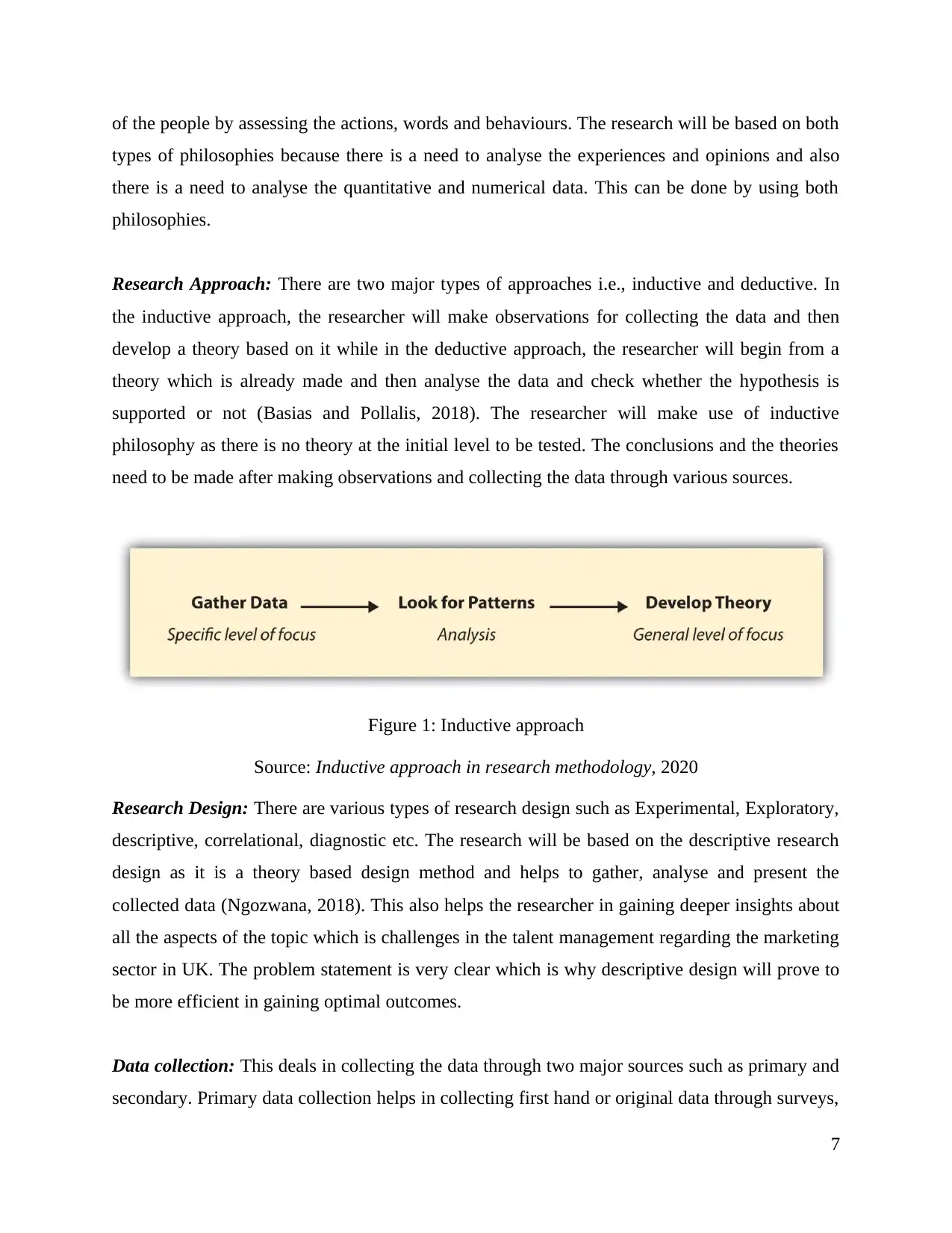
of the people by assessing the actions, words and behaviours. The research will be based on both
types of philosophies because there is a need to analyse the experiences and opinions and also
there is a need to analyse the quantitative and numerical data. This can be done by using both
philosophies.
Research Approach: There are two major types of approaches i.e., inductive and deductive. In
the inductive approach, the researcher will make observations for collecting the data and then
develop a theory based on it while in the deductive approach, the researcher will begin from a
theory which is already made and then analyse the data and check whether the hypothesis is
supported or not (Basias and Pollalis, 2018). The researcher will make use of inductive
philosophy as there is no theory at the initial level to be tested. The conclusions and the theories
need to be made after making observations and collecting the data through various sources.
Figure 1: Inductive approach
Source: Inductive approach in research methodology, 2020
Research Design: There are various types of research design such as Experimental, Exploratory,
descriptive, correlational, diagnostic etc. The research will be based on the descriptive research
design as it is a theory based design method and helps to gather, analyse and present the
collected data (Ngozwana, 2018). This also helps the researcher in gaining deeper insights about
all the aspects of the topic which is challenges in the talent management regarding the marketing
sector in UK. The problem statement is very clear which is why descriptive design will prove to
be more efficient in gaining optimal outcomes.
Data collection: This deals in collecting the data through two major sources such as primary and
secondary. Primary data collection helps in collecting first hand or original data through surveys,
7
types of philosophies because there is a need to analyse the experiences and opinions and also
there is a need to analyse the quantitative and numerical data. This can be done by using both
philosophies.
Research Approach: There are two major types of approaches i.e., inductive and deductive. In
the inductive approach, the researcher will make observations for collecting the data and then
develop a theory based on it while in the deductive approach, the researcher will begin from a
theory which is already made and then analyse the data and check whether the hypothesis is
supported or not (Basias and Pollalis, 2018). The researcher will make use of inductive
philosophy as there is no theory at the initial level to be tested. The conclusions and the theories
need to be made after making observations and collecting the data through various sources.
Figure 1: Inductive approach
Source: Inductive approach in research methodology, 2020
Research Design: There are various types of research design such as Experimental, Exploratory,
descriptive, correlational, diagnostic etc. The research will be based on the descriptive research
design as it is a theory based design method and helps to gather, analyse and present the
collected data (Ngozwana, 2018). This also helps the researcher in gaining deeper insights about
all the aspects of the topic which is challenges in the talent management regarding the marketing
sector in UK. The problem statement is very clear which is why descriptive design will prove to
be more efficient in gaining optimal outcomes.
Data collection: This deals in collecting the data through two major sources such as primary and
secondary. Primary data collection helps in collecting first hand or original data through surveys,
7
Paraphrase This Document
Need a fresh take? Get an instant paraphrase of this document with our AI Paraphraser
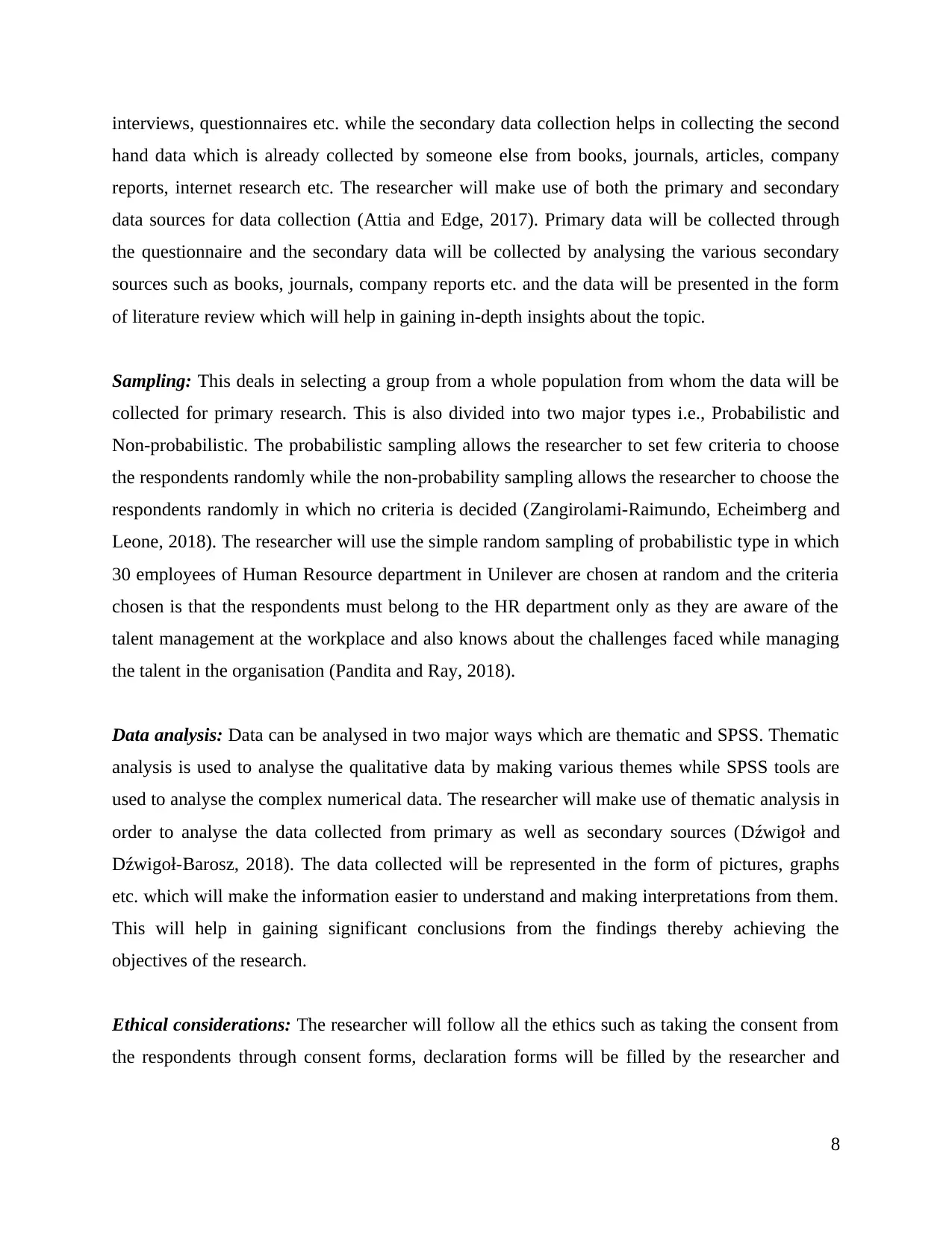
interviews, questionnaires etc. while the secondary data collection helps in collecting the second
hand data which is already collected by someone else from books, journals, articles, company
reports, internet research etc. The researcher will make use of both the primary and secondary
data sources for data collection (Attia and Edge, 2017). Primary data will be collected through
the questionnaire and the secondary data will be collected by analysing the various secondary
sources such as books, journals, company reports etc. and the data will be presented in the form
of literature review which will help in gaining in-depth insights about the topic.
Sampling: This deals in selecting a group from a whole population from whom the data will be
collected for primary research. This is also divided into two major types i.e., Probabilistic and
Non-probabilistic. The probabilistic sampling allows the researcher to set few criteria to choose
the respondents randomly while the non-probability sampling allows the researcher to choose the
respondents randomly in which no criteria is decided (Zangirolami-Raimundo, Echeimberg and
Leone, 2018). The researcher will use the simple random sampling of probabilistic type in which
30 employees of Human Resource department in Unilever are chosen at random and the criteria
chosen is that the respondents must belong to the HR department only as they are aware of the
talent management at the workplace and also knows about the challenges faced while managing
the talent in the organisation (Pandita and Ray, 2018).
Data analysis: Data can be analysed in two major ways which are thematic and SPSS. Thematic
analysis is used to analyse the qualitative data by making various themes while SPSS tools are
used to analyse the complex numerical data. The researcher will make use of thematic analysis in
order to analyse the data collected from primary as well as secondary sources (Dźwigoł and
Dźwigoł-Barosz, 2018). The data collected will be represented in the form of pictures, graphs
etc. which will make the information easier to understand and making interpretations from them.
This will help in gaining significant conclusions from the findings thereby achieving the
objectives of the research.
Ethical considerations: The researcher will follow all the ethics such as taking the consent from
the respondents through consent forms, declaration forms will be filled by the researcher and
8
hand data which is already collected by someone else from books, journals, articles, company
reports, internet research etc. The researcher will make use of both the primary and secondary
data sources for data collection (Attia and Edge, 2017). Primary data will be collected through
the questionnaire and the secondary data will be collected by analysing the various secondary
sources such as books, journals, company reports etc. and the data will be presented in the form
of literature review which will help in gaining in-depth insights about the topic.
Sampling: This deals in selecting a group from a whole population from whom the data will be
collected for primary research. This is also divided into two major types i.e., Probabilistic and
Non-probabilistic. The probabilistic sampling allows the researcher to set few criteria to choose
the respondents randomly while the non-probability sampling allows the researcher to choose the
respondents randomly in which no criteria is decided (Zangirolami-Raimundo, Echeimberg and
Leone, 2018). The researcher will use the simple random sampling of probabilistic type in which
30 employees of Human Resource department in Unilever are chosen at random and the criteria
chosen is that the respondents must belong to the HR department only as they are aware of the
talent management at the workplace and also knows about the challenges faced while managing
the talent in the organisation (Pandita and Ray, 2018).
Data analysis: Data can be analysed in two major ways which are thematic and SPSS. Thematic
analysis is used to analyse the qualitative data by making various themes while SPSS tools are
used to analyse the complex numerical data. The researcher will make use of thematic analysis in
order to analyse the data collected from primary as well as secondary sources (Dźwigoł and
Dźwigoł-Barosz, 2018). The data collected will be represented in the form of pictures, graphs
etc. which will make the information easier to understand and making interpretations from them.
This will help in gaining significant conclusions from the findings thereby achieving the
objectives of the research.
Ethical considerations: The researcher will follow all the ethics such as taking the consent from
the respondents through consent forms, declaration forms will be filled by the researcher and
8

also there is no biasness in choosing the respondents (Mohajan, 2018). The authenticity of all the
secondary sources and the data will be maintained during the data collection.
LO 3
P5 Data Analysis
Secondary research (Literature Review)
Literature Overview helps the researcher to discuss about the information which is
already published related to the topic of the research. It is considered as the summary of the
information which was searched already by the other researchers. The researcher will make use
of various secondary sources such as books, journals, research papers, articles etc. to evaluate the
challenges faced by the marketing sectors of companies like Unilever in managing the talent at
their workplace.
According to Narayanan, Rajithakumar and Menon (2019), talent management is the most
important responsibility of the HR in the companies but this does not means that having an HR
department will manage the talent. It needs the development and effective implementation of
various strategies to manage the talent at the workplace which will help in retaining and
recruiting the highly talented and skilled employees. The authors also examined that the
employees are the biggest assets of the organisations therefore talent management helps in
maximizing the value of the employees.
As per the view of Collings, Mellahi and Cascio (2019), talent management benefits the
companies in many ways such as by improving the performance, allowing the company to stay
competitive, drives innovation, helps in forming productive teams, decreases turnover and also
motivate and encourage others to grow. The companies use various strategies to manage the
talent such as hiring only the top employees, hiring the promising specialists to develop them and
many more other innovative strategies. This helps the HR of the companies to manage the talent
of the employees and also enhance their skills and abilities.
On the contrary, the authors Crane and Hartwell (2019), argued that there are various challenges
which are faced by the HR department of the company. The major challenge which is faced is
the higher demands of total compensation. It becomes very difficult for the HR to keep the
employees satisfied along with keeping the costs low. The employee needs to decide about the
9
secondary sources and the data will be maintained during the data collection.
LO 3
P5 Data Analysis
Secondary research (Literature Review)
Literature Overview helps the researcher to discuss about the information which is
already published related to the topic of the research. It is considered as the summary of the
information which was searched already by the other researchers. The researcher will make use
of various secondary sources such as books, journals, research papers, articles etc. to evaluate the
challenges faced by the marketing sectors of companies like Unilever in managing the talent at
their workplace.
According to Narayanan, Rajithakumar and Menon (2019), talent management is the most
important responsibility of the HR in the companies but this does not means that having an HR
department will manage the talent. It needs the development and effective implementation of
various strategies to manage the talent at the workplace which will help in retaining and
recruiting the highly talented and skilled employees. The authors also examined that the
employees are the biggest assets of the organisations therefore talent management helps in
maximizing the value of the employees.
As per the view of Collings, Mellahi and Cascio (2019), talent management benefits the
companies in many ways such as by improving the performance, allowing the company to stay
competitive, drives innovation, helps in forming productive teams, decreases turnover and also
motivate and encourage others to grow. The companies use various strategies to manage the
talent such as hiring only the top employees, hiring the promising specialists to develop them and
many more other innovative strategies. This helps the HR of the companies to manage the talent
of the employees and also enhance their skills and abilities.
On the contrary, the authors Crane and Hartwell (2019), argued that there are various challenges
which are faced by the HR department of the company. The major challenge which is faced is
the higher demands of total compensation. It becomes very difficult for the HR to keep the
employees satisfied along with keeping the costs low. The employee needs to decide about the
9
⊘ This is a preview!⊘
Do you want full access?
Subscribe today to unlock all pages.

Trusted by 1+ million students worldwide
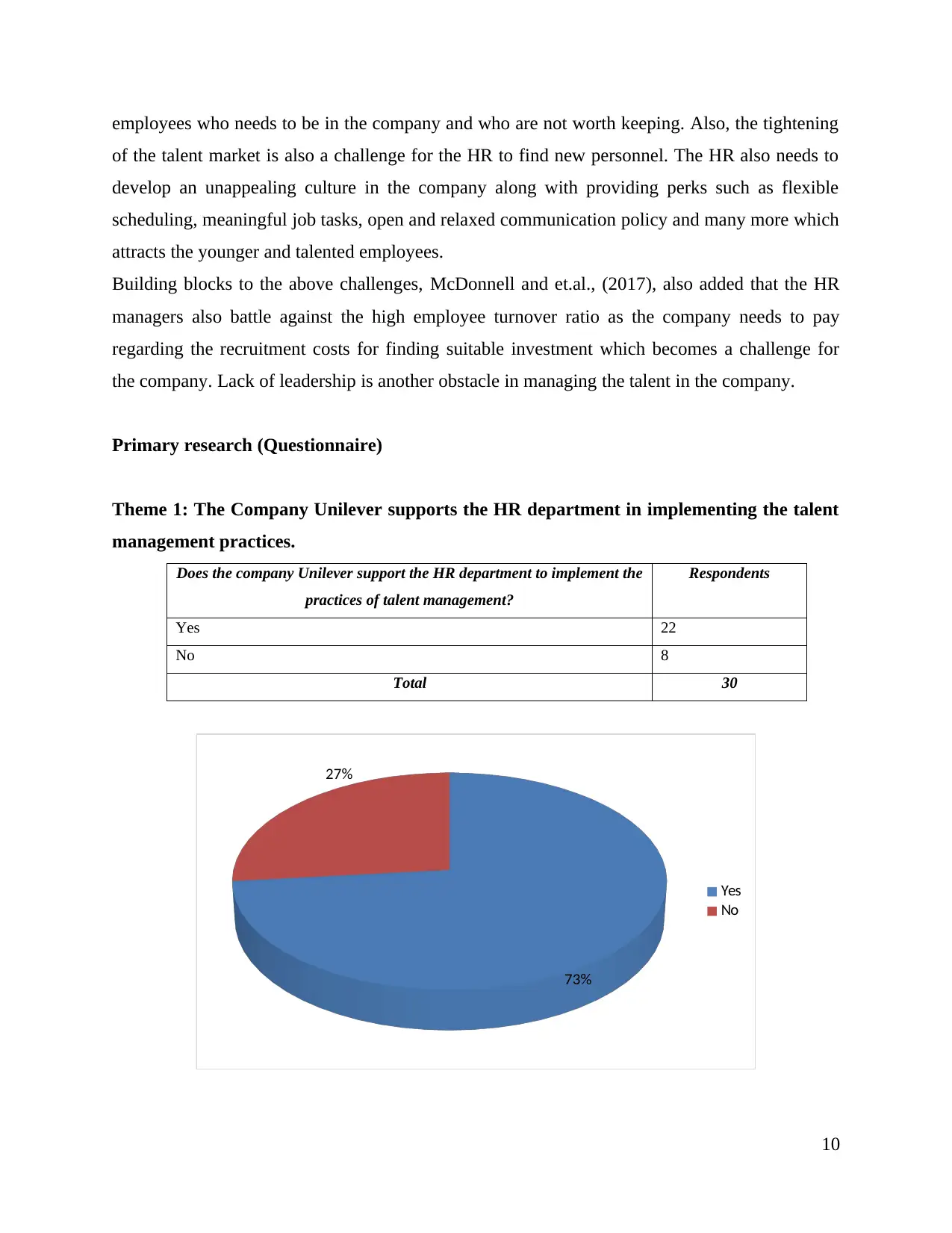
employees who needs to be in the company and who are not worth keeping. Also, the tightening
of the talent market is also a challenge for the HR to find new personnel. The HR also needs to
develop an unappealing culture in the company along with providing perks such as flexible
scheduling, meaningful job tasks, open and relaxed communication policy and many more which
attracts the younger and talented employees.
Building blocks to the above challenges, McDonnell and et.al., (2017), also added that the HR
managers also battle against the high employee turnover ratio as the company needs to pay
regarding the recruitment costs for finding suitable investment which becomes a challenge for
the company. Lack of leadership is another obstacle in managing the talent in the company.
Primary research (Questionnaire)
Theme 1: The Company Unilever supports the HR department in implementing the talent
management practices.
Does the company Unilever support the HR department to implement the
practices of talent management?
Respondents
Yes 22
No 8
Total 30
73%
27%
Yes
No
10
of the talent market is also a challenge for the HR to find new personnel. The HR also needs to
develop an unappealing culture in the company along with providing perks such as flexible
scheduling, meaningful job tasks, open and relaxed communication policy and many more which
attracts the younger and talented employees.
Building blocks to the above challenges, McDonnell and et.al., (2017), also added that the HR
managers also battle against the high employee turnover ratio as the company needs to pay
regarding the recruitment costs for finding suitable investment which becomes a challenge for
the company. Lack of leadership is another obstacle in managing the talent in the company.
Primary research (Questionnaire)
Theme 1: The Company Unilever supports the HR department in implementing the talent
management practices.
Does the company Unilever support the HR department to implement the
practices of talent management?
Respondents
Yes 22
No 8
Total 30
73%
27%
Yes
No
10
Paraphrase This Document
Need a fresh take? Get an instant paraphrase of this document with our AI Paraphraser
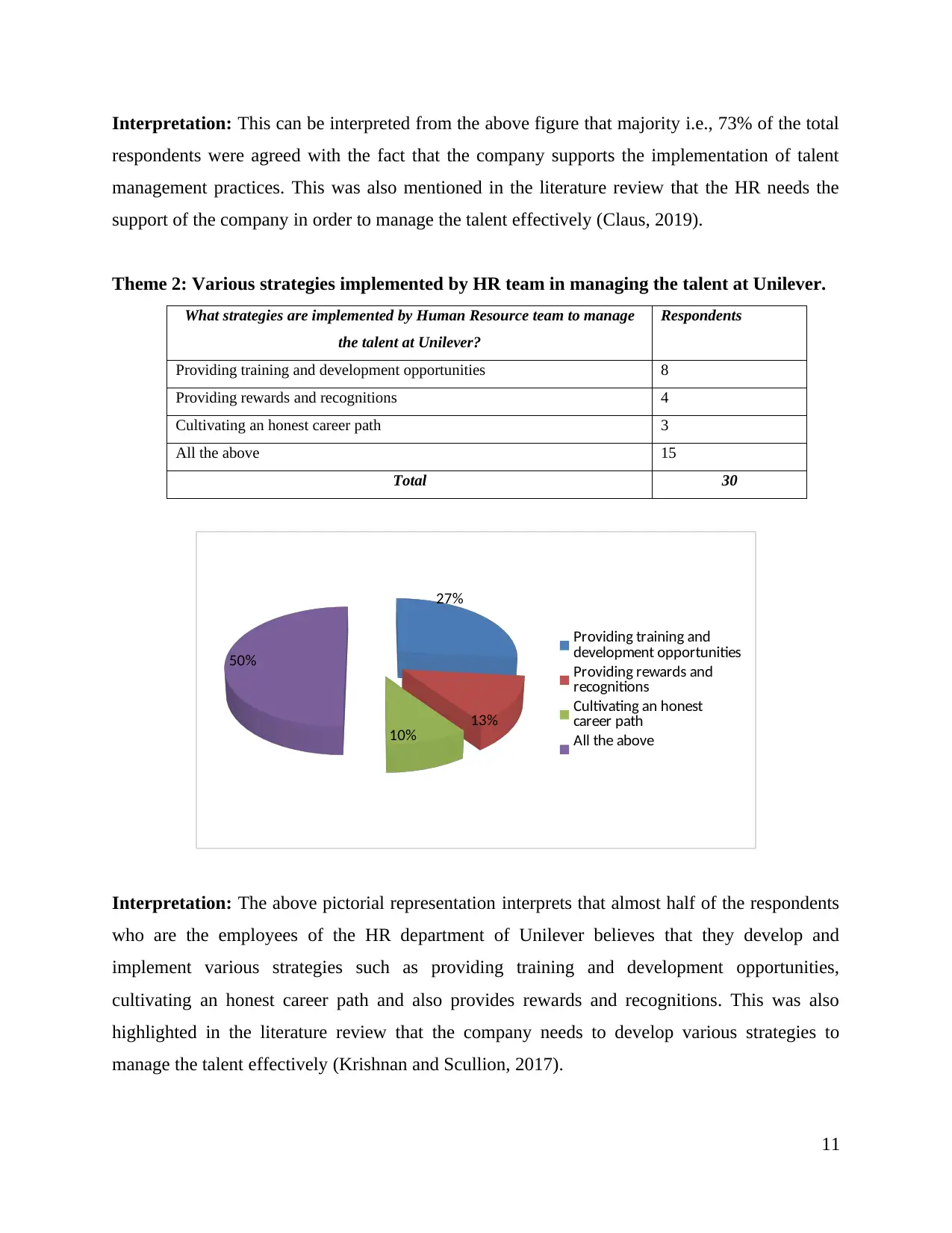
Interpretation: This can be interpreted from the above figure that majority i.e., 73% of the total
respondents were agreed with the fact that the company supports the implementation of talent
management practices. This was also mentioned in the literature review that the HR needs the
support of the company in order to manage the talent effectively (Claus, 2019).
Theme 2: Various strategies implemented by HR team in managing the talent at Unilever.
What strategies are implemented by Human Resource team to manage
the talent at Unilever?
Respondents
Providing training and development opportunities 8
Providing rewards and recognitions 4
Cultivating an honest career path 3
All the above 15
Total 30
27%
13%
10%
50%
Providing training and
development opportunities
Providing rewards and
recognitions
Cultivating an honest
career path
All the above
Interpretation: The above pictorial representation interprets that almost half of the respondents
who are the employees of the HR department of Unilever believes that they develop and
implement various strategies such as providing training and development opportunities,
cultivating an honest career path and also provides rewards and recognitions. This was also
highlighted in the literature review that the company needs to develop various strategies to
manage the talent effectively (Krishnan and Scullion, 2017).
11
respondents were agreed with the fact that the company supports the implementation of talent
management practices. This was also mentioned in the literature review that the HR needs the
support of the company in order to manage the talent effectively (Claus, 2019).
Theme 2: Various strategies implemented by HR team in managing the talent at Unilever.
What strategies are implemented by Human Resource team to manage
the talent at Unilever?
Respondents
Providing training and development opportunities 8
Providing rewards and recognitions 4
Cultivating an honest career path 3
All the above 15
Total 30
27%
13%
10%
50%
Providing training and
development opportunities
Providing rewards and
recognitions
Cultivating an honest
career path
All the above
Interpretation: The above pictorial representation interprets that almost half of the respondents
who are the employees of the HR department of Unilever believes that they develop and
implement various strategies such as providing training and development opportunities,
cultivating an honest career path and also provides rewards and recognitions. This was also
highlighted in the literature review that the company needs to develop various strategies to
manage the talent effectively (Krishnan and Scullion, 2017).
11
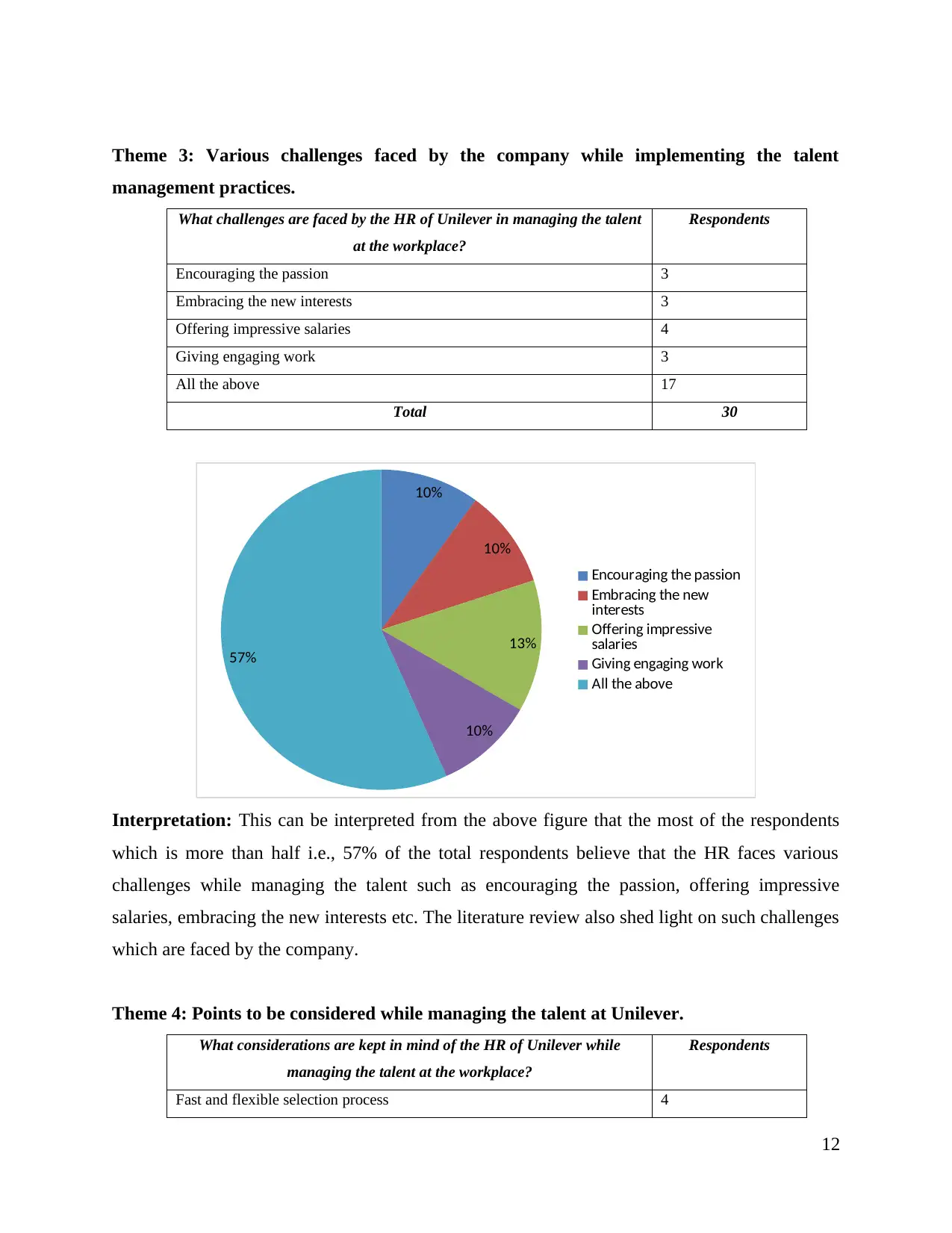
Theme 3: Various challenges faced by the company while implementing the talent
management practices.
What challenges are faced by the HR of Unilever in managing the talent
at the workplace?
Respondents
Encouraging the passion 3
Embracing the new interests 3
Offering impressive salaries 4
Giving engaging work 3
All the above 17
Total 30
10%
10%
13%
10%
57%
Encouraging the passion
Embracing the new
interests
Offering impressive
salaries
Giving engaging work
All the above
Interpretation: This can be interpreted from the above figure that the most of the respondents
which is more than half i.e., 57% of the total respondents believe that the HR faces various
challenges while managing the talent such as encouraging the passion, offering impressive
salaries, embracing the new interests etc. The literature review also shed light on such challenges
which are faced by the company.
Theme 4: Points to be considered while managing the talent at Unilever.
What considerations are kept in mind of the HR of Unilever while
managing the talent at the workplace?
Respondents
Fast and flexible selection process 4
12
management practices.
What challenges are faced by the HR of Unilever in managing the talent
at the workplace?
Respondents
Encouraging the passion 3
Embracing the new interests 3
Offering impressive salaries 4
Giving engaging work 3
All the above 17
Total 30
10%
10%
13%
10%
57%
Encouraging the passion
Embracing the new
interests
Offering impressive
salaries
Giving engaging work
All the above
Interpretation: This can be interpreted from the above figure that the most of the respondents
which is more than half i.e., 57% of the total respondents believe that the HR faces various
challenges while managing the talent such as encouraging the passion, offering impressive
salaries, embracing the new interests etc. The literature review also shed light on such challenges
which are faced by the company.
Theme 4: Points to be considered while managing the talent at Unilever.
What considerations are kept in mind of the HR of Unilever while
managing the talent at the workplace?
Respondents
Fast and flexible selection process 4
12
⊘ This is a preview!⊘
Do you want full access?
Subscribe today to unlock all pages.

Trusted by 1+ million students worldwide
1 out of 20
Related Documents
Your All-in-One AI-Powered Toolkit for Academic Success.
+13062052269
info@desklib.com
Available 24*7 on WhatsApp / Email
![[object Object]](/_next/static/media/star-bottom.7253800d.svg)
Unlock your academic potential
Copyright © 2020–2025 A2Z Services. All Rights Reserved. Developed and managed by ZUCOL.





